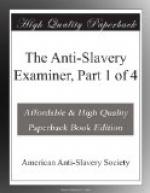7. Because, throughout the Mosaic system, God warns them against holding their servants in such a condition as they were held in by the Egyptians. How often are the Israelites pointed back to the grindings of their prison-house! What motives to the exercise of justice and kindness towards their servants, are held out to their fears in threatened judgements; to their hopes in promised good; and to all within them that could feel, by those oft repeated words of tenderness and terror! “For ye were bondmen in the land of Egypt”—waking anew the memory of tears and anguish, and of the wrath that avenged them.
That the argument derived from the condition of the Israelites in Egypt, and God’s condemnation of it, may be appreciated, it is important that the Egyptian bondage should be analyzed. We shall then be able to ascertain, of what rights the Israelites were plundered, and what they retained.
EGYPTIAN BONDAGE ANALYZED. (1.) The Israelites were not dispersed among the families of Egypt, the property of individual owners[A]. They formed a separate community. See Gen. xlvi. 35. Ex. viii. 22, 24, and ix. 26, and x. 23, and xi. 7, and ii. 9, and xvi. 22, and xvii. 5.
[Footnote A: The Egyptians evidently had domestic servants living in their families; these may have been slaves; allusion is made to them in Exodus ix. 14, 20, 21. But none of the Israelites were included in this class.]
(2.) They had the exclusive possession of the land of Goshen[B], one of the richest and most productive parts of Egypt. Gen. xlv. 18, and xlvii. 6, 11, 27. Ex. xii. 4, 19, 22, 23, 27.
[Footnote B: The land of Goshen was a large tract of country, east of the Pelusian arm of the Nile, and between it and the head of the Red Sea, and the lower border of Palestine. The probable centre of that portion, occupied by the Israelites, could hardly, have been less than 60 miles from the city. From the best authorities it would seem that the extreme western boundary of Goshen must have been many miles distant from Egypt. See “Exodus of the Israelites out of Egypt,” an able article by Professor Robinson, in the Biblical Repository for October, 1832.]
(3.) They lived in permanent dwellings. These were houses, not tents. In Ex. xii. 6, the two side posts, and the upper door posts of the houses are mentioned, and in the 22d, the two side posts and the lintel. Each family seems to have occupied a house by itself—Acts vii. 20, Ex. xii. 4—and from the regulation about the eating of the Passover, they could hardly have been small ones—Ex. xii. 4—and probably contained separate apartments, and places for seclusion. Ex. ii. 2, 3; Acts vii. 20. They appear to have been well apparelled. Ex. xii. 11. To have had their own burial grounds. Ex. xiii. 19, and xiv. 11.
(4.) They owned “a mixed multitude of flocks and herds,” and “very much cattle.” Ex. xii. 32, 37, 38.




